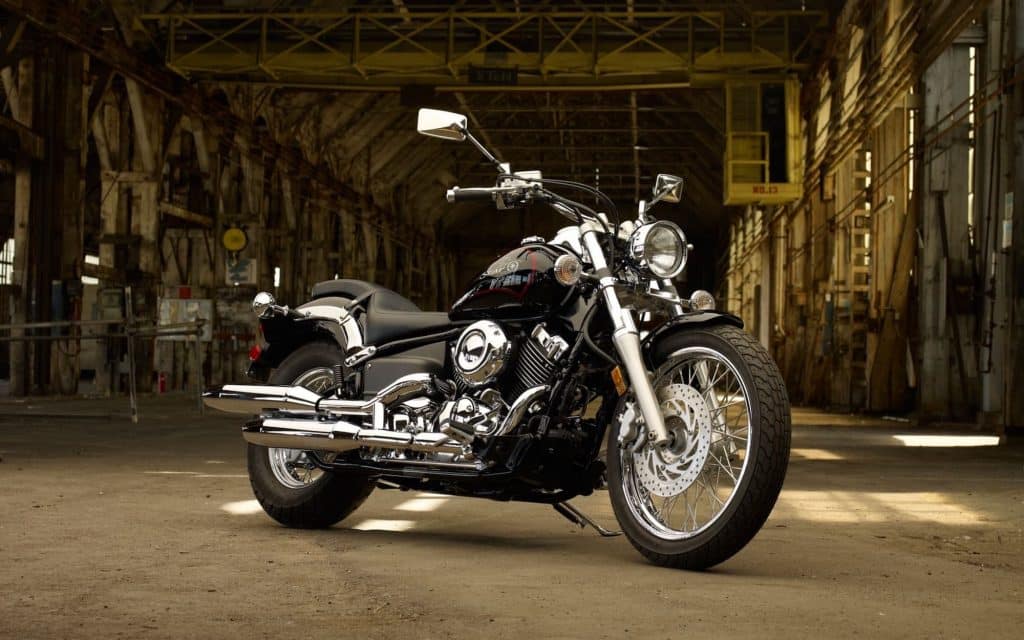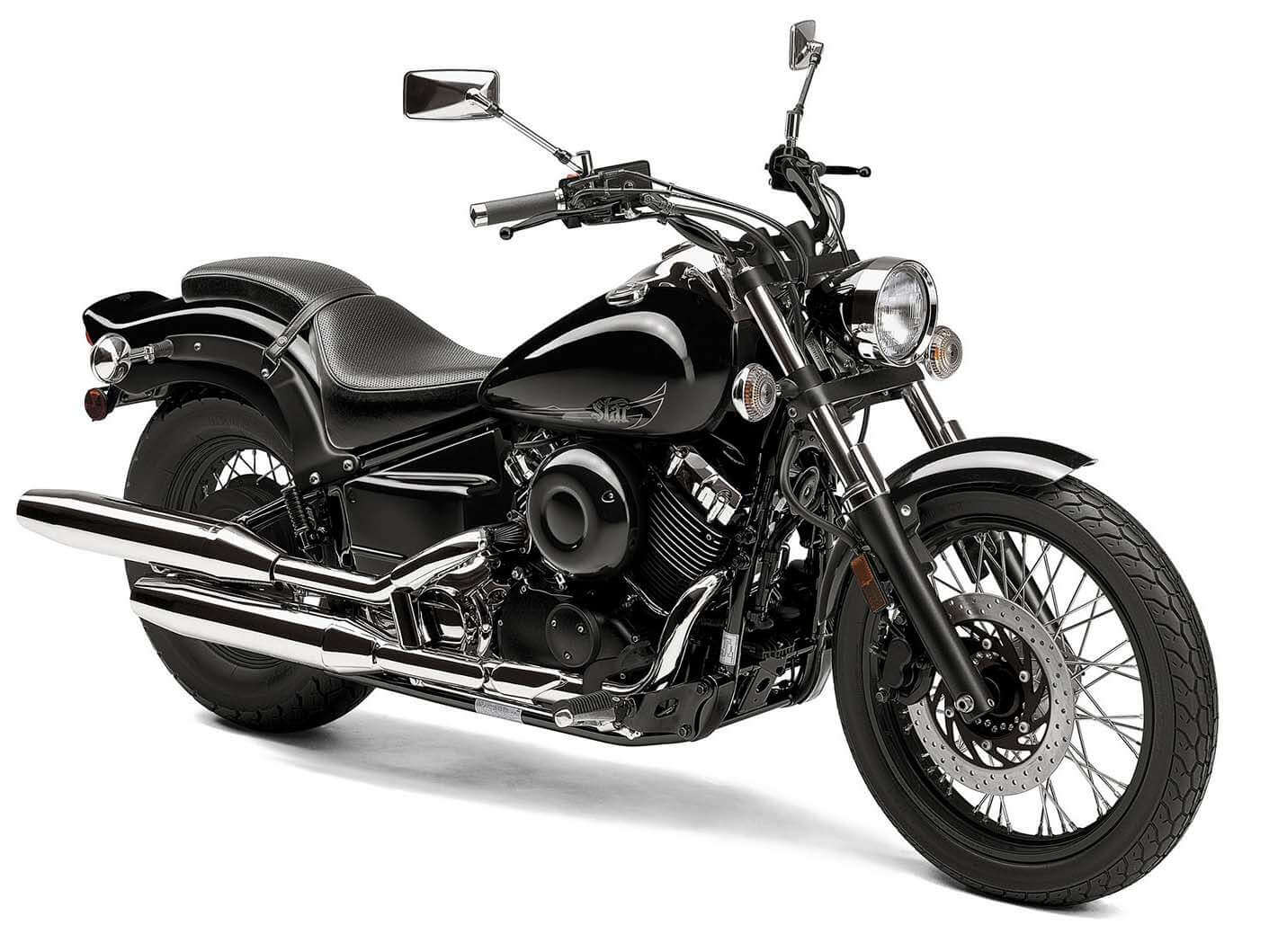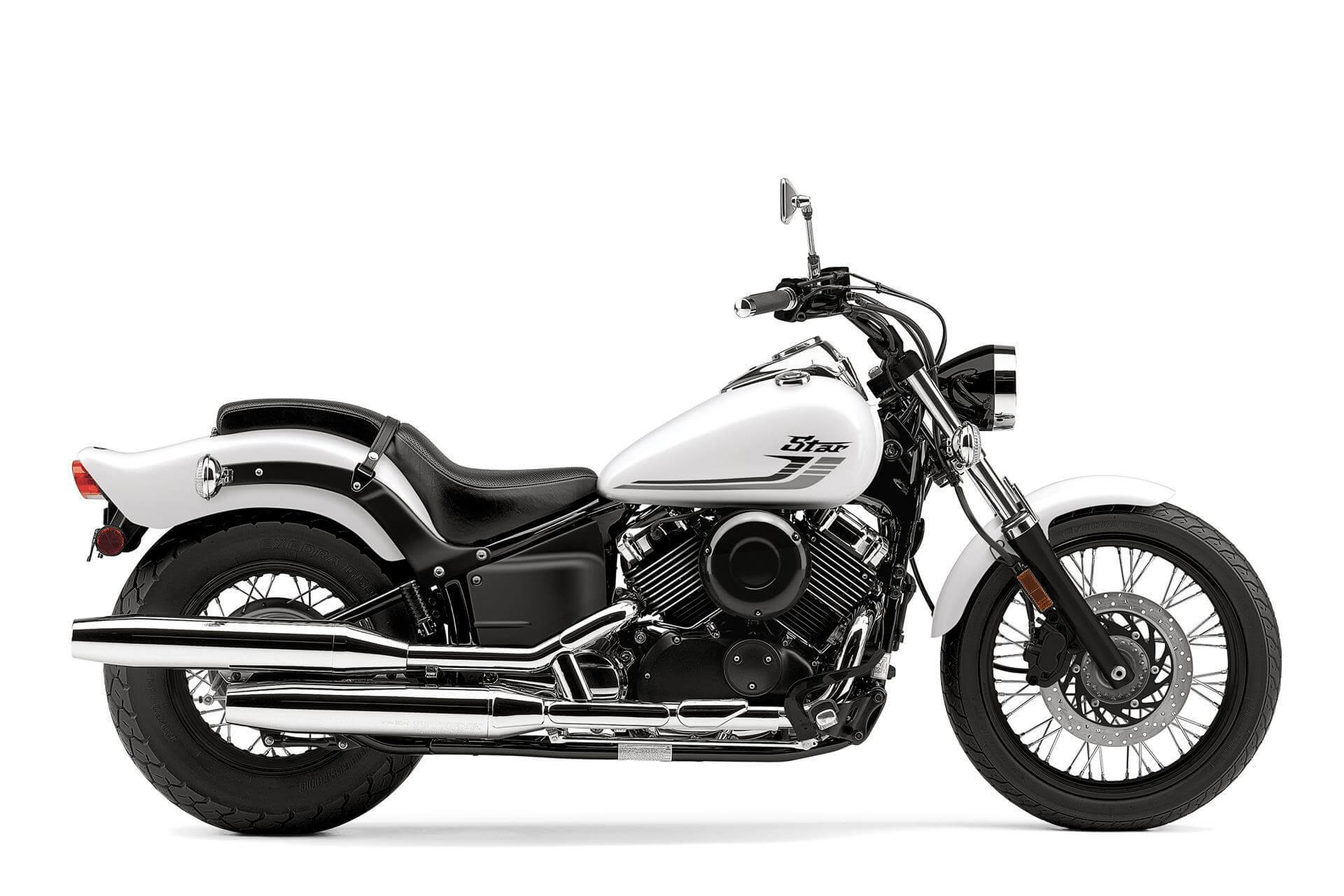Yamaha V Star 650 (XVS650) Maintenance Schedule and Service Intervals
This is the maintenance schedule and associated service intervals for the Yamaha V Star 650, also known as the XVS650, XVS650A, and DragStar 650, depending on region.
The V Star 650 (also known as the XVS650) is a cruiser motorcycle with a middleweight engine. It was produced since 1997 and remained unchanged for nearly two decades until 2016, when Yamaha stopped producing it. There were some cosmetic changes of course, but nothing major.
The Yamaha V Star 650 is one of the lowest-maintenance motorcycles you can buy. The combination of a shaft drive, an air-cooled V-twin, and a low compression ratio of 9.0:1 mean that there’s little to do on the V-Star 650. (No fuel injection, though!)
There were a few variants of the V Star 650 (much like the V Star 1100):
- V Star 650 Custom: The base version. It also came in a Midnight Custom blacked out version with black paint and trim.
- V Star 650 Classic: Same as the custom, but with a wider front wheel, metal fenders, longer bodywork, less styling, drag-style handlebars, a wider seat, and other styling differences
- V Star 650 Silverado: Same additions as the classic, but with saddlebags and a few other touring editions
So this maintenance schedule table applies to the 1998-2016 V Star 650 (XVS650), including Classic, Custom, and Silverado.
Pics of all these are below.
This site has links for things like oil and spark plugs from which we earn a commission (which unfortunately nobody can save, not even us). If you appreciate this work, then please use those links. Thanks!
What you need to service the Yamaha V Star 650
If you want to service your V Star 650, you’ll need the below consumable items.
| Part | Yamaha V Star 650 spec |
|---|---|
| Oil | The manual for this aging motorcycle says 10W-30 or 20W-40, but Yamalube 10W-40 will cover you. Tighten the oil drain bolt to 43 Nm / 31 lb-ft. |
| Oil filter | Needs to be changed every second time you change the oil. A good drop-in replacement is the Hiflofiltro HF145. |
| Spark Plugs | NGK DPR7EA-9. Make sure it’s gapped correctly to 0.8-0.9mm (get a gapping tool) and torqued to 18 Nm / 13 lb-ft. |
| Air filter | You can normally clean the air filter. If you need to replace it, the part number is 4TR-14451-00. The K&N part YA-6598 is a drop-in replacement. |
| Brake pads/shoes | For the front disc front use EBC FA179HH. You can also buy Niche’s V Star 650 brake pad and shoe set. |
| Brake fluid | Use DOT 4 brake fluid to service the brake system. (the clutch has a cable) |
| Final drive oil | You need SAE80 API “GL-4” hypoid gear oil such as Lucas Oil 80W-90. Tighten the bolt to 23 Nm / 17 lb-ft. |
Overall service intervals for the Yamaha V Star 650
Overall, the service intervals for the V Star 650 / Drag Star 650 are 4000 miles / 6000 km or 6 months between oil changes, also checking the spark plug. Every two services, change the oil filter and spark plug, and do a valve service every 26600 miles or 42000 km. There’s more detail on all the individual checks in the full maintenance schedule below.
Yamaha V Star 650 Maintenance Schedule
Below is the maintenance schedule for the Yamaha V Star 650 (a.k.a. the XVS650) range of motorcycles.
Notes on the maintenance schedule:
- From the end of the maintenance schedule, repeat the maintenance intervals in the pattern shown.
- The break-in schedule is not shown (as these bikes are all broken in).
- The European maintenance schedule for the Drag Star 650 is formatted a little differently, but the intervals are the same.
Some things were added to later years of the maintenance schedule, like replacing brake fluid. But they apply equally to earlier years.
Similarly, later in Yamaha’s manuals, they stopped recommending using compressed air to clean the air filter, for fear of damage of the filter (and then the engine).
Also in earlier maintenance schedules (from the manuals), the order of items mentioned changed. For example, adjusting valve clearance wasn’t mentioned first. But that’s trivial — the intervals were the same.
Yamaha V Star 650 maintenance schedule
Below is the maintenance schedule for the V Star 650 per the US manual, in miles.
The European maintenance schedule is formatted differently, specifying things every 6000 km or 6 months. These are the same intervals for the US manual.
| mi x 1000 | 4 | 8 | 12 | 16 | 20 | |
|---|---|---|---|---|---|---|
| km x 1000 | 7 | 13 | 19 | 25 | 31 | |
| months | 6 | 12 | 18 | 24 | 30 | Every |
| Change engine oil (Yamalube 10W-40) | ✓ | ✓ | ✓ | ✓ | ✓ | |
| Replace oil filter. | ✓ | ✓ | ||||
| Check spark plug condition. Adjust gap (0.8-0.9mm) and clean | ✓ | ✓ | ✓ | |||
| Replace spark plugs (NGK DPR7EA-9) | ✓ | ✓ | ||||
| Clean air filter (do not use compressed air). Replace if necessary (K&N YA-6598) | ✓ | ✓ | ✓ | ✓ | ✓ | More often if riding in dusty/wet conditions |
| Check and adjust valve clearance when engine is cold | 26600 miles (42000 km) | |||||
| Adjust throttle cable free play. Lubricate the cable and grip housing. | ✓ | ✓ | ✓ | ✓ | ✓ | |
| Check and adjust carburetor sync. | ✓ | ✓ | ✓ | ✓ | ✓ | |
| Check and adjust engine idle speed. | ✓ | ✓ | ✓ | ✓ | ✓ | |
| Check front brake operation, fluid level, and for leakage. | ✓ | ✓ | ✓ | ✓ | ✓ | |
| Check and replace brake pads if necessary (see above for part #s) | ✓ | ✓ | ✓ | ✓ | ✓ | |
| Check rear brake operation. Adjust cable if necessary. | ✓ | ✓ | ✓ | ✓ | ✓ | |
| Replace rear brake shoes if necessary. | ✓ | ✓ | ✓ | ✓ | ✓ | |
| Adjust brake lever free play. | ✓ | ✓ | ✓ | ✓ | ✓ | |
| Replace brake fluid (Castrol DOT 4) and inner parts of brake master cylinder and brake caliper pistons | 2 years | |||||
| Check the brake hoses for cracks and damage | ✓ | ✓ | ✓ | ✓ | ✓ | |
| Replace the brake hoses | 4 years | |||||
| Check brake switches (not mentioned in earlier manuals) | ✓ | ✓ | ✓ | ✓ | ✓ | |
| Check fuel hoses for crack and damage. Replace if necessary | ✓ | ✓ | ✓ | ✓ | ✓ | |
| Replace fuel filter. | ✓ | |||||
| Check clutch operation and for fluid leakage. Correct if necessary. | ✓ | ✓ | ✓ | ✓ | ✓ | |
| Check final drive for oil leakage. | ✓ | ✓ | ✓ | ✓ | ✓ | |
| Replace final gear oil (Lucas Oil 80W-90) | ✓ | |||||
| Lubricate control and meter cables (Protect all cable life) | ✓ | ✓ | ✓ | ✓ | ✓ | |
| Check wheels for runout and damage. Tighten spokes if necessary | ✓ | ✓ | ✓ | ✓ | ✓ | |
| Check tyres for cracks and damage. Replace if necessary. | ✓ | ✓ | ✓ | ✓ | ✓ | |
| Check wheel bearings for smooth rotation. Replace if necessary | ✓ | ✓ | ✓ | ✓ | ✓ | |
| Check swingarm pivot bearing assembly for looseness. | ✓ | |||||
| Moderately repack swingarm bearing with lithium soap-based grease | ✓ | |||||
| Check steering bearing assembly for looseness. | ✓ | ✓ | ✓ | ✓ | ✓ | |
| Moderately repack steering bearing with lithium soap-based grease | ✓ | |||||
| Check shock absorber operation and for leakage. Replace if necessary | ✓ | ✓ | ✓ | ✓ | ✓ | |
| Lubricate brake lever with silicone grease lightly | ✓ | ✓ | ✓ | ✓ | ✓ | |
| Lubricate clutch lever, brake pedal, and shift pedal with lithium soap-based grease lightly. | ✓ | ✓ | ✓ | ✓ | ✓ | |
| Check sidestand pivot operation and lubricate with lithium soap-based grease. | ✓ | ✓ | ✓ | ✓ | ✓ | |
| Check sidestand switch and clean or replace if necessary. | ✓ | ✓ | ✓ | ✓ | ✓ | |
| Check front fork operation and for leakage. | ✓ | ✓ | ✓ | ✓ | ✓ | |
| Check crankcase breather hose for cracks or damage. Replace if necessary | ✓ | ✓ | ✓ | ✓ | ✓ | |
| Check exhaust system for leakage. Retighten/replace gaskets if necessary. | ✓ | ✓ | ✓ | ✓ | ✓ | |
| Check evap control system (if fitted) for damage. Replace if necessary. | ✓ | ✓ | ||||
| Check lights, signals, and switches. | ✓ | ✓ | ✓ | ✓ | ✓ |
About the Yamaha V Star 650

The Yamaha V Star 650 isn’t the most powerful cruiser on the market. It’s not even the most powerful 650 cc motorcycle.
But to those who love the V Star 650, the engine is “just right”. Its oversquare engine with a mild compression ratio puts out around 37 lb-ft (about 50 Nm) of torque at 3,000. At just over 220 kg (500 lb) wet, that torque is enough to keep you hustling along all the way well into illegal speeds.
The V Star 650 has a 649cc air-cooled 70 degree V-twin and drives its rear wheel through a wide-ratio five speed transmission, and a shaft final drive — a rarity on a moderate sized cruiser. It is fed through twin Mikuni carburetors. The V Star 650 never received fuel injection during its long tenure, which means it was one of the last carburettor-fuelled cruisers you could buy new.
There’s a lot to like about the Yamaha V Star 650. And the first of these things is that it’s a good looking motorcycle!
Among “metric” cruisers, Yamaha has had one of the most successful runs. Yes, other Japanese (and European and even American Metric) brands have had their own individual winners, but the V Star line has been very popular for being an engaging, easy to ride, and very good looking series of motorcycles.
Because the V Star 650 is less than 660 cc and has a pretty low power to weight ratio, it’s learner legal (“LAMS”-approved) in markets like Australia and New Zealand. So if you’re looking for a stylish cruiser that wasn’t built to be learner legal… this is your jam!
There’s a few things to remember when riding the V Star 650.
Firstly, it is carburetor-fed. This means it has a choke. Don’t forget to use it when it’s cold… and don’t forget to turn it off when it’s hot! The choke is near the rear of the tank under your left leg (many are in this position on Yamaha cruisers, like the V Star 250 or example).
Secondly, it doesn’t have ABS, and there’s quite a lot of weight on the rear. This means that it’s easy to lock up the rear if you’re a little lazy with braking. A progressive hand and foot is key.
Finally, the seat is quite low and the controls are forwards. This isn’t surprising if you’ve ridden cruisers. But many people own the V Star as their first bike, so it bears mentioning. You might feel like you lack a little control compared to the small bike you did your test on.
Despite the small engine, it’s very easy to ride the V Star 650 at a range of speeds, from lazily idling through traffic to going up to freeway speeds (and beyond). The Silverado touring package gives you a big shield and bags to make sure the only limit is your horizon… or the gas tank.
Equipment on the V Star 650 is basic. There’s a single brake disc at the front and a single drum at the rear. Suspension is non-adjustable other than preload for the rear shock.
The best thing about the V Star 650 is that it’s so under-stressed that it’s very reliable. Valve services are every 26600 miles or 42000 km — very high for an air-cooled bike! And it has a shaft drive, so there’s no belt to keep in tension or chain to lube.
Just keep changing the oil and you’re probably good to go for a very, very long time.
Manual for the Yamaha V Star 650
The above information was gleaned from the owner’s manual for the Yamaha V Star 650, with input from the owner’s manuals from may years, comparing changes and differences.
Some items (small things) weren’t mentioned in some manuals, or not called out explicitly. We’ve included everything in the above schedule as there’s no harm.


Below is a screenshot of the maintenance schedule from the European manual showing the different format (but basically same contents).

You can download the maintenance schedule from Yamaha’s website here.

























